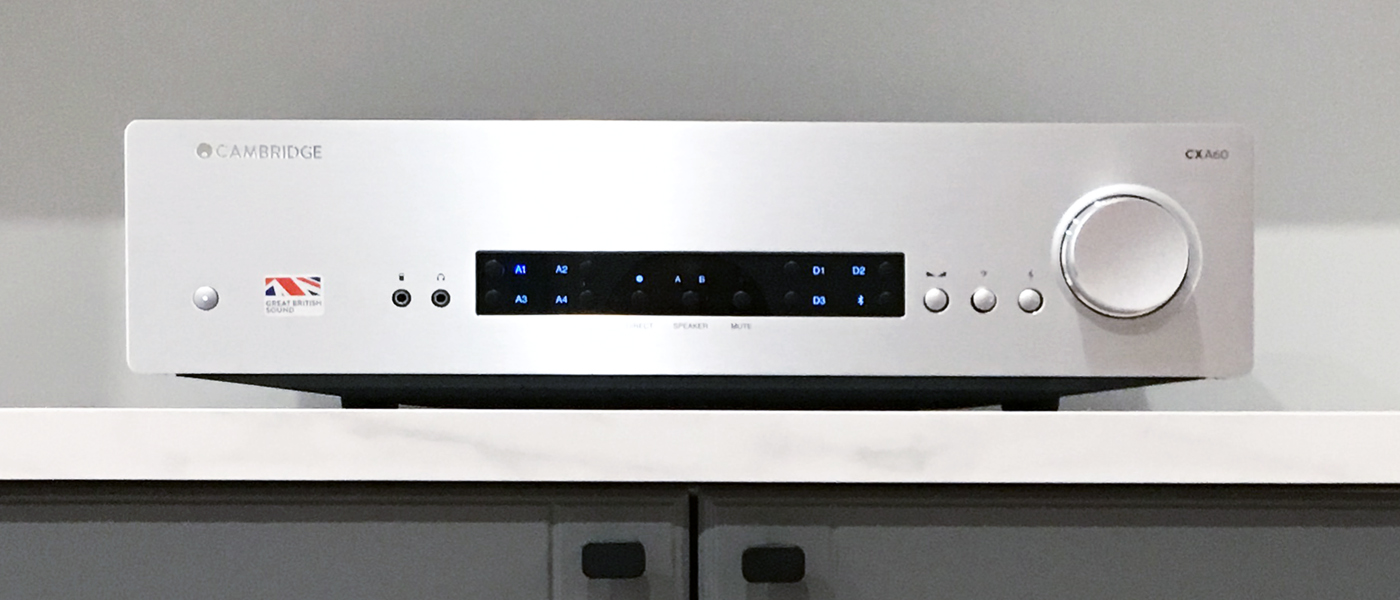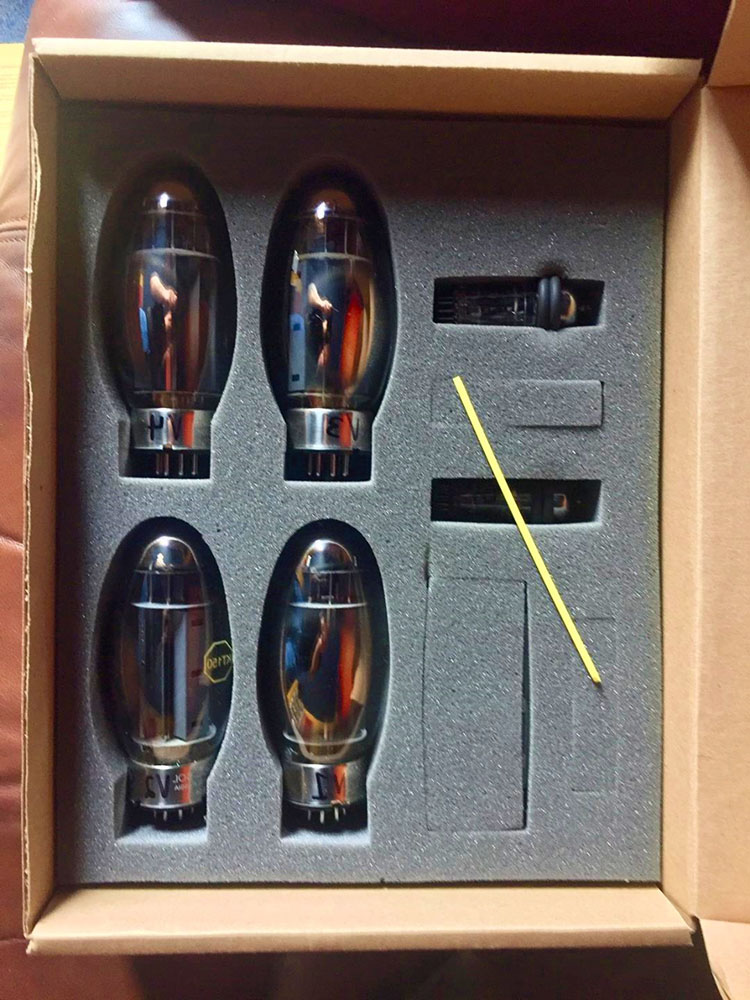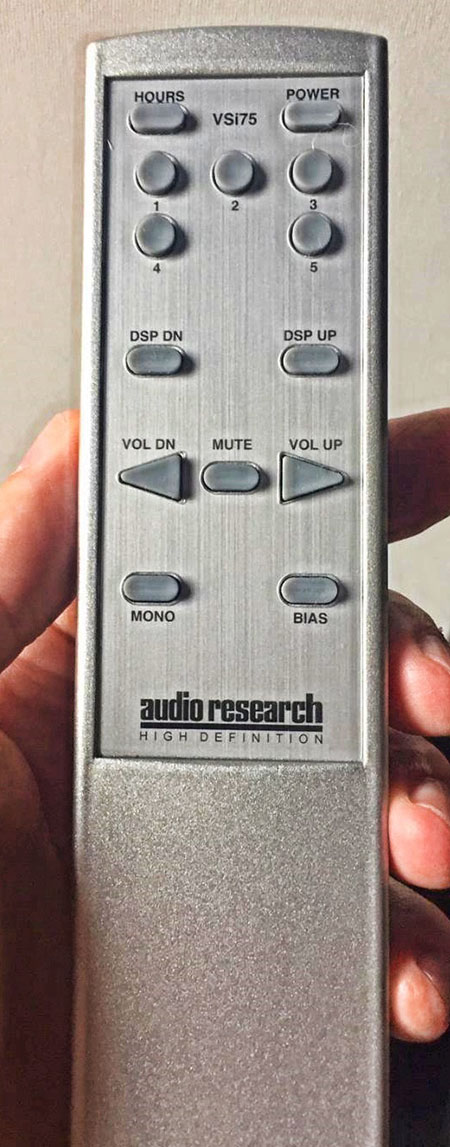
Many audiophiles seem to gush about the warm, euphonic tube sound, while still others lament the soft, mushy bass output and lack of sparkle in the higher frequencies. I found the sound of the VSi75 to fall somewhere in between both tube and solid-state in its audio presentation and feel that it might actually appeal to both crowds.
Audio Research VSi75 Integrated Amplifier
- 75 watts per channel
- Solid, clean construction
- Uncluttered easy to read front panel
- Biasing the tubes is straightforward & easy
- Built in timer keeps track of tube hours
Secrets Sponsor
I must admit that I am a solid-state kind of guy. I don’t particularly like fussing with my equipment once I set it up and power it ON. I don’t care to wait for things to “warm up” or “settle in”. I want my music and I want it NOW. That said, it is also true that good things come to those that wait and patience is a virtue. Those of you that are used to tube equipment or are perhaps a connoisseur of fine vinyl probably already know this. I have listened to enough tube amps in the past to know that they provide a different listening and setup experience than solid-state devices, so I was prepared for the challenges that can come with tubes (or valves, as they are referred to in Europe). I found setting up the VSi75 to be painless… and delightfully engaging.
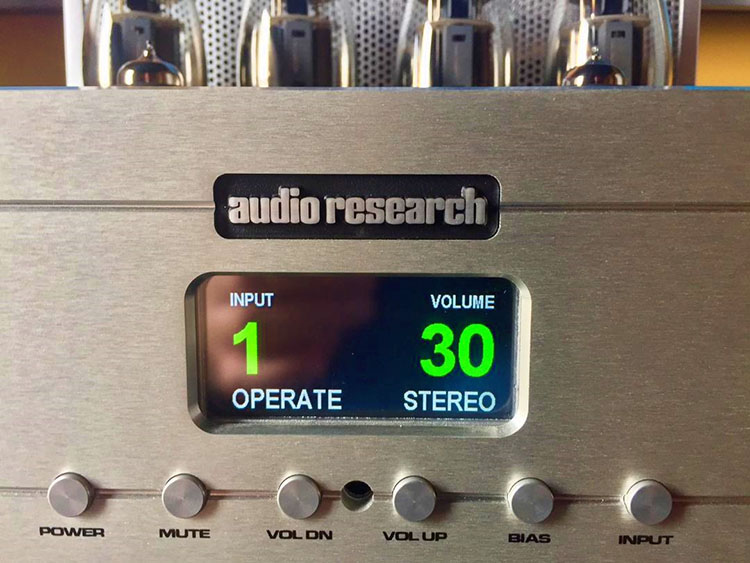
Power Output:
75 watts per channel continuous from 20Hz to 20kHz @ 1 kHz armonic distortion
THD @ 1kHz:
1.5% @ 75 watts, .05% @ 1 watt
Power Bandwidth:
(-3dB points) 12Hz to 70kHz
Frequency Response:
(-3dB points at 1 watt) 1.0Hz to 70 kHz
Input Sensitivity:
0.55V RMS Single-ended for rated output (32.5dB gain into 8 ohms)
Input Impedance:
52.5K ohms Single-ended
Inputs:
5 x single-ended RCA
Maximum Input Voltage:
10V RMS
Output Polarity:
Non-Inverting
Front Panel Controls:
Volume up, Volume down (103 steps), Power, Input, Mute, Bias
Output Regulation:
approximately 2dB 8-ohm load to open circuit (damping factor approximately 4)
Output Taps:
8 ohms, 4 ohms
Overall Negative Feedback:
4dB
Slew Rate:
10 volts/microsecond
Rise Time:
4 microseconds
Power Supplies:
electronically regulated Low and High voltage supplies for input stages, automatic 40 sec. warm-up/brown-out mute
Power Supply Energy Storage:
approximately 350 joules
Power Requirements:
100-125VAC @ 60Hz (200-250VAC @ 50Hz) 400 watts at rated output, 600 watts maximum, 210 watts at idle 1.0 watt power off
Power Tubes:
2 x matched pair KT150
Driver Tubes:
2 x 6H30
Dimensions (WxHxD):
14.5”x 9.25” x 16.25”, rear connectors extend .88” beyond chassis
Weight:
36.4 lbs
MSRP:
$8500
Company:
SECRETS Tags:
audio research vsi75 integrated amplifier, amplifier review, integrated amplifier, stereo amplifier, tube amplifier, Amplifier Review 2018
- MOON by Simaudio 240i Integrated Amplifier Review
- Vacuum Tube Audio M-125 Mono-Tube Power Amplifier Review
- Vacuum Tube Audio ST-120 Tube Power Amplifier Review
With a solid, brushed aluminum chassis, the VSi75 weighs over 36 pounds and has an almost industrial look to it. It looks like someone made the unit by hand from the ground up and took their sweet time doing it. The internal circuit boards (from what I could see) look like they have widely spaced etchings, with the components being well-spaced with ample room to breathe. The VSi75 upgrades over its predecessor (VSi60) include a matched set of four KT150 power output tubes, two 6H30 driver tubes, some solid-state regulation, and a JFET input stage. The VSi75 is single-ended only, so all five inputs are RCAs with very sturdy posts. It also has a tape output, which is handy should you possess a reel-to-reel rig. The RCA connectors in the back are very solid and substantial so you will never have to worry about them wearing out or coming loose over time.

On the matter of the tubes, most are manufactured either in the USSR or China. I’ll not get into the joys of swapping out tubes (like vinylphiles and phono cartridges), and my comments will stick to the supplied stock tubes from ARC. The KT150s are bigger than their predecessors and provide more output than the KT88s. The internal workings of the VSi75 did not have to be beefed up for these newer, more powerful tubes, because the boards and wiring are already “over-built” enough to handle the extra output. The tubes came in a separately boxed section from the amplifier that provides ample foam protection. Each tube is hand-labeled so you can place them in their proper connector.
Also included is a yellow plastic screw driver so you can bias each tube to match the output voltage. They should all be matched to 65mA and I’ll go into the trimming process later. Each tube base has a key slot, so you should have no trouble lining them up and popping them in correctly.
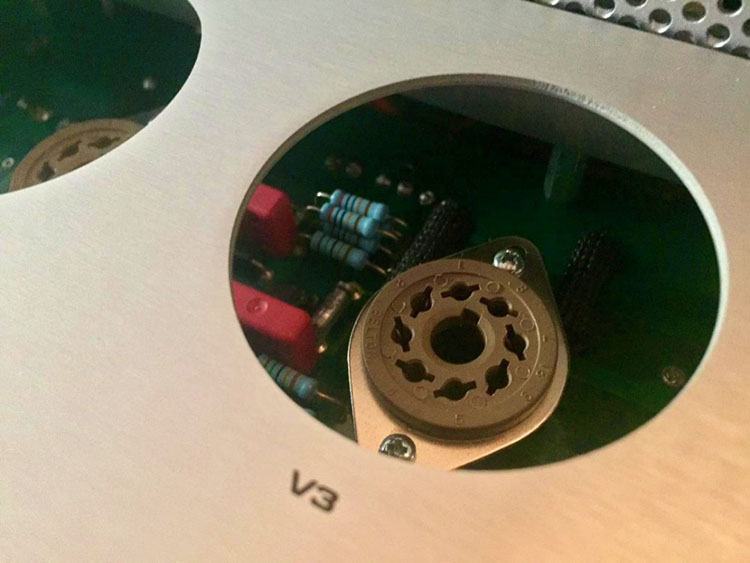
I always wear gloves when handling tubes to prevent oily finger smudges, which causes them to heat unevenly, and in case one should break while being inserted. Remember to push straight down and not at an angle. Once the tubes were set, I attached the supplied power cord and fired it up. I know it sounds simple, but the act of putting in the tubes and biasing them makes for a more intimate connection with the VSi75, than a solid-state device. It’s sort of a “Hey, I did that.” experience.
The VSi75 comes with a remote made from solid aluminum. It is a simple device that I found it to be quite useful, and not just because it powers the unit on and switches inputs. When the VSi75 is powered on, it takes 40 seconds (counted down on the display) before you can use the volume, which starts at a default of ZERO and MUTE. This is a design choice that prevents someone from turning the unit on with the volume all the way up. Unmuting and turning the volume up is easily done from the remote.
Also, checking the bias for each tube is controlled from the remote as well as checking the number of hours you have on the tubes (they are good for about 2000 hours before they need replacing). All this info can be read from the large front panel display, which is dimmable. I really liked the display, as it was easy to see from across the room and it could be dimmed all the way off if you just want to bask in the tubes’ dim glow.
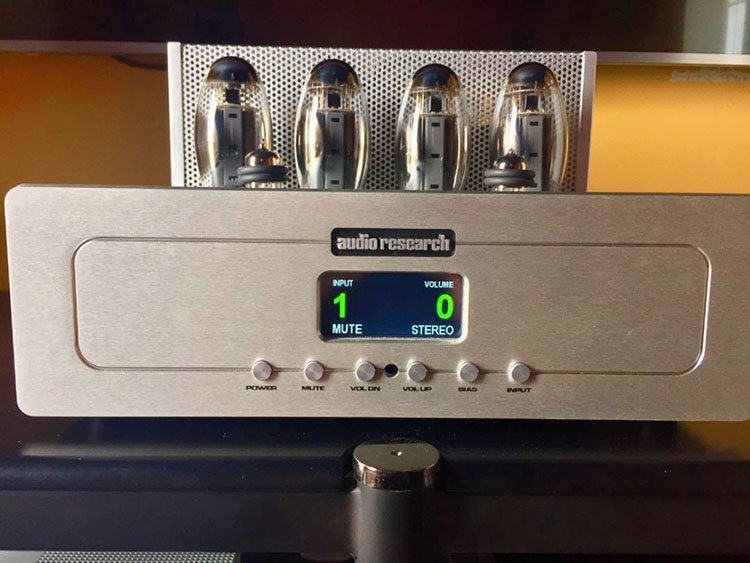
Biasing the tubes will allow you to optimize the output for each one so they output the same volume per channel, and it prolongs their service life. Biased too hot and the life is decreased, too little and the sound quality takes a hit. I found the tubes were already-well matched and only a slight adjustment was needed to bring them even.
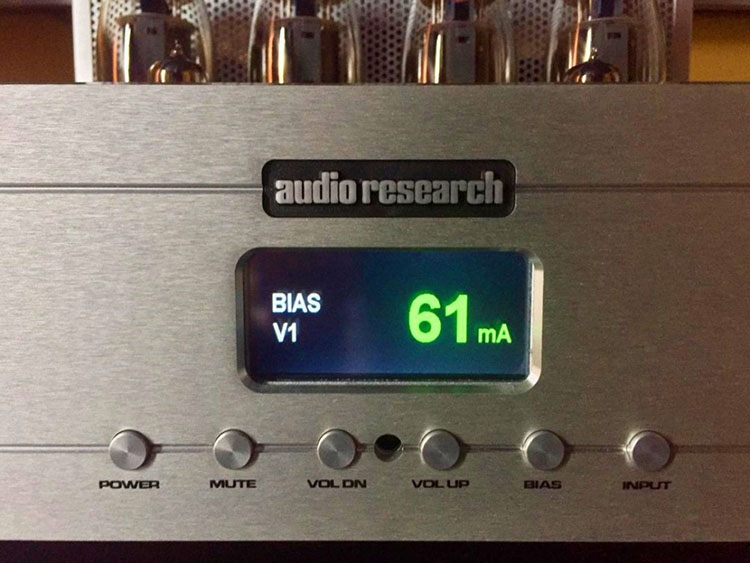
The included plastic flat-head driver works well for this task. Why plastic? Do you think it would be a clever idea to fish around in this thing with a metal stick with all that high voltage inside waiting to be released? Also, I recommend biasing after the tubes have had ample time to warm up, say around 20-30 minutes. From the remote, you select each tube to be biased and just watch the display as you make your incremental adjustments. I know some amps out there are self-biasing, but this really was not a difficult chore and it gave me that nostalgic feeling; like tweaking a turntable.
I have read elsewhere that it is recommended to burn the VSi75 in for over 100 hours before you give it a serious listen. I never had the luxury of that time table, but I can make a few comments about the sound over time in general. When I listened for my first three-hour session, I thought the sound was a bit harsh and the bass to be slightly bloomy. The soundstage was also a bit two-dimensional and lacking in depth.
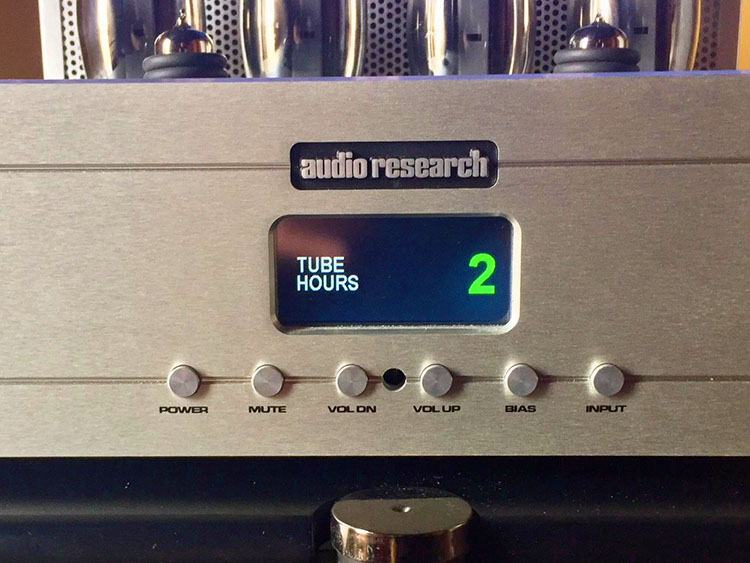
As the days went on, these things resolved, and the top end sparkled, but never sounded overly etched or strident. The bass, which I found surprisingly robust for a tube amp, had plenty of power and gave the music a warm, solid foundation. The word “burnished” came to mind several times during my auditioning. It had authority but with a warm, soft analog edge. I’ll try to describe it in more detail in the listening section later.
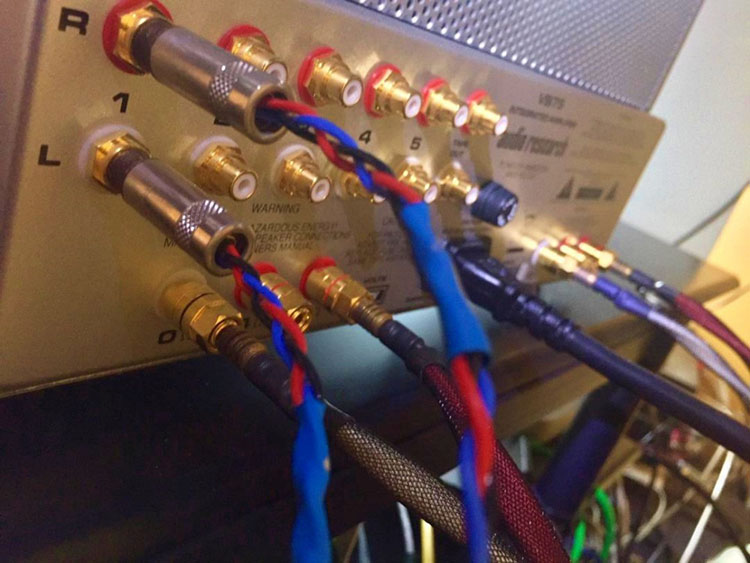
For my listening set-up, I used an OPPO UDP-203, Kimber PBJ interconnects, Zu Audio Julian speaker cables, and Revel Concerta2 F36 full range speakers. I did not put a subwoofer into the mix, though that could have been an option. I wanted to judge the VSi75 without the assist of a sub. It never fails to impress me how good a simple two channel set-up can sound. Two components and a set of speakers… Boom!
Secrets Sponsor
Most of my critical listening came with the VSi75 having over 20 hours of burn-in on it. I can not comment on the sound quality after more than 100 hours, but I can extrapolate that over time, the sound got better with a more 3D sound-stage and overall, a smoother and mellower sound. I am not a proponent of solid state device burn-in, but I am when it comes to tubes. Be patient, the sound evolution is part of the process.

Human vocals are usually a great test for testing the naturalness of the mid-range. I played some Frank Sinatra, Live at the Sands and got a really good sense of the venue’s space. Besides the extraneous noises of people laughing and glasses clinking, the feeling of being there was almost palpable. Through the smoky room, Sinatra’s voice floated above the din and sounded full and natural. The highs were there, but I did notice a slight roll-off of the tape hiss from the digitally-remastered recording. That was true for most of the older recordings in my collection. The treble detail was still there, just that slight hiss was gone. Not a terrible thing in my book. Another good voice recording was Roxy Music’s Avalon. Brain Ferry’s restrained and seductive sound was mesmerizing and yet so enjoyable. The bass underpinning was also well-supported and had a slightly “fat” quality to it that really enhanced the emotion of the band’s iconic sound. This recording was a surround remaster SACD, but even in stereo it still sounded open and spacious.

Flipping genres, I listened to some of Handel’s Organ Concertos. The orchestra was well spaced out in front of the organ, which was centered on the backwall. The strings had nice bite and a warm sheen. Again, there was a lack of stridency in the upper registers, but not a lack of detail. Though the organ was a small chamber instrument, it had plenty of sparkle and the bass notes were solid. Moving about 150 years forward in time, I compared Handle to Aaron Copland’s Symphony for Organ and Orchestra with E. Power Biggs on the organ at Avery Fisher Hall in NYC. Recorded in 1968, this organ is miked closely and has a very large personality. The music is deliciously jazzy with syncopated rhythms that would challenge any world class orchestra. The bass from the organ is quite present as are the large brass instruments and tympani. It was here that I thought the VSi75 would run out of propane, but it played this music loudly and without any hint of being pushed too hard. Again, I was aware that the 40-year-old tape hiss was being attenuated and softened, but I never felt that the treble details suffered. I would never have thought of organ music in general being played with a tube amp before, but the VSi75 could really reproduce a 32-foot pedal with authority!

If your tastes run more to rock-n-roll, I played everything from the newly remastered Sgt. Pepper album to The Who’s Greatest Hits. I really am hopelessly “old-school”, I guess. With The Who’s Join Together, after the synthesizer and harmonica intro, I noticed that when the bouncing bass line comes in, it was big and in your face.
The VSi75 laid it down with power. I expected the bass to sag a bit, but that didn’t happen. Roger Daltrey’s husky tenor sounded full and lush. Boy, he could really belt out the vocals back then. Today, of course, he’s deaf as door knob… but who today can capture the raw emotion of his voice? Certainly no one from American Idol.
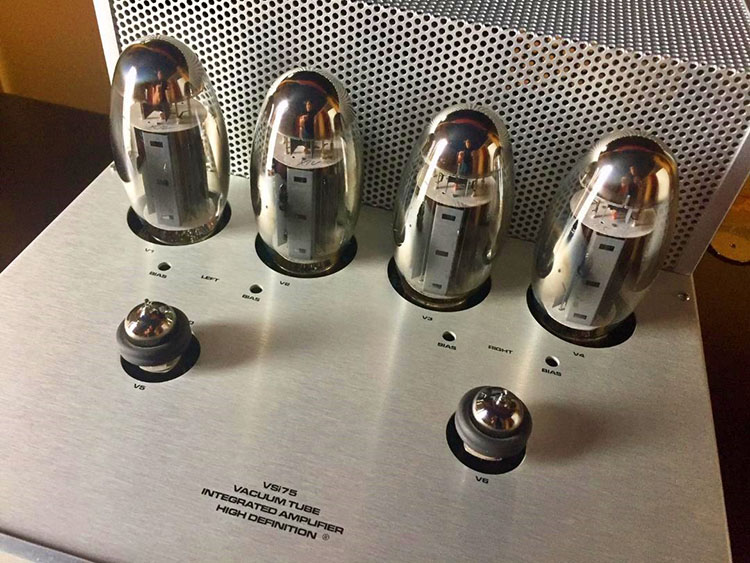
Overall, the VSi75 has the finesse to play any type of music genre, with perhaps an edge in reproducing vocals and acoustical instruments. It is refined enough for classical music, yet can punch out rock-n-roll, too.
- Sound that appeals to solid state or tube lovers
- Plenty of dynamic power
- Easy setup
- Easy to read panel display
- Perhaps a headphone jack
Because of the solid-state and tube marriage, the VSi75 has some sound characteristics of both and can easily win the ears from both sides of the aisle. I have found in general, that bass can be a bit weak and flabby with tubes. That is not the case with the VSi75. Though the bass was a slightly rounded on the bottom octave, it had plenty of slam and muscle, even when playing my favorite pipe organ music. The warmth of tubes is partially due to the removal of treble harshness, which most people will enjoy. This thing is built like a tank and the quality can be seen on the outside and heard on the inside, where it counts. The VSi75 is easy to set-up and operate, so no one should feel intimidated by the glowing glass tubes on top. The built-in features keep track of the tube life, assist in biasing, and the power-up process ensures you don’t accidentally damage anything with an unintentional volume power surge. The solid remote should last as long as the unit. Though it’s not backlit, I usually only find that a minus in home theaters. The Audio Research VSi75 is an investment piece; whether you are moving up to your first tube amp or are thinking about setting up a primo stereo system from the ground up. The Audio Research VSi75 integrated amplifier is a sound choice that will pay musical dividends for many years to come.


